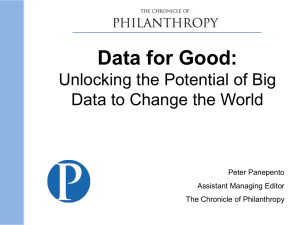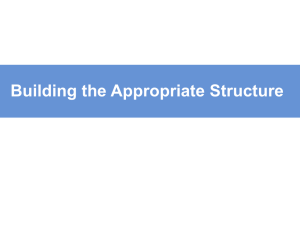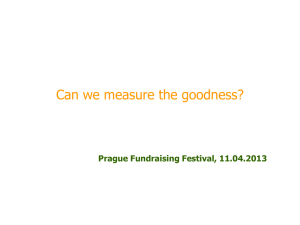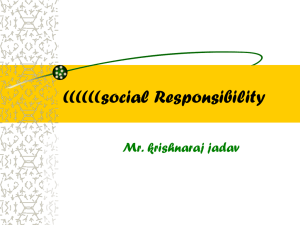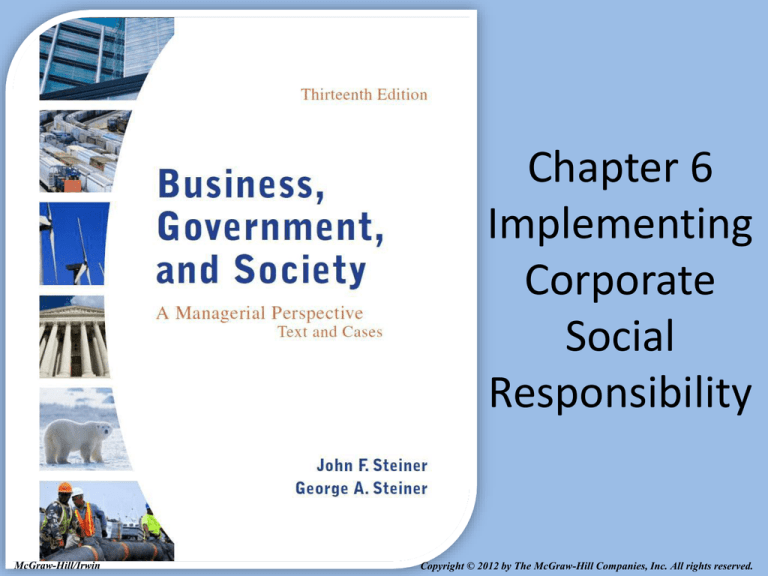
Chapter 6
Implementing
Corporate
Social
Responsibility
McGraw-Hill/Irwin
Copyright © 2012 by The McGraw-Hill Companies, Inc. All rights reserved.
The Bill & Melinda Gates Foundation
o Bill Gates was a slender, intense boy with a messy
room and a dazzling mind who often challenged his
teachers in class
o He attended Harvard University, but left to pursue his
fascination with computers
o At age 19, Gates founded Microsoft Corporation and
twelve years later he was a billionaire
6-2
The Bill & Melinda Gates Foundation
o He was energetic, independent, and confrontational
and developed the reputation of a fanatical competitor
willing to appropriate any technology and crush
market rivals
6-3
The Bill & Melinda Gates Foundation
o Gates established the Bill & Melinda Gates
Foundation, which has an endowment of $33 billion
o The foundation’s work is based on a two values:
o All lives—no matter where they are being led—have
equal value
o To whom much is given, much is expected
o The foundation has given out more than $13.4 billion
6-4
Figure 6.1 - Sources of Pressure for Social
Responsibility
6-5
Leadership and Business Models
o Business model: The underlying idea or theory that
explains how a business will create value by making
and selling products or service in the market
o Types:
o The progressive model
o The traditional model
6-6
Leadership and Business Models
o A traditional business model is one in which the
central strategy for creating value is based on meeting
market demands while complying with the law
o A progressive business model creates value by
meeting market demands and, in the process,
mitigating social problems or improving society in
some way
6-7
Figure 6.2 - A Spectrum of Responses to
Social Demands
6-8
Figure 6.3 - A Model Process of CSR
Implementation
6-9
A Model of CSR Implementation: CSR
Review
o CSR implementation includes:
o An assessment of the firm’s current situation and
activities
o Discovery of the firm’s core values
o Engagement of stakeholders
o A key source of values is the mission statement
o Mission statement: A brief statement of the basic
purpose of a corporation
6-10
Figure 6.4 - Basic Stakeholder Map for
ArcelorMittal
6-11
Figure 6.5 - Stakeholder Map Articulated to Show
Government Stakeholders
6-12
A Model of CSR Implementation: CSR
Strategy
o Strategy: A basic approach, method, or plan for
achieving an objective
o A company defining its CSR strategy must first find
an objective, or a vision of what it will achieve, then
create a method for reaching it
6-13
A Model of CSR Implementation: CSR
Strategy
o For large firms the task of setting priorities is
complex because multiple, sometimes conflicting,
stakeholder demands exist
o Michael Porter and Mark Kramer suggest an
“essential test” for the worthiness of any additional
social initiative
6-14
Implementation of CSR Strategy
o Steps for CSR implementation:
o Create an effective CSR decision-making structure
o Develop an action plan that sets forth a multitude of
tasks that will bring the strategy to fruition
o Establish performance targets and timelines for their
accomplishment
6-15
Implementation of CSR Strategy
o Setup incentives to encourage achievement of goals
and targets and encourage accountability
o Align corporate culture with strategic intent
6-16
CSR Implementation: Reporting and
Verification
o Assessment and reporting create transparency and
allows managers to evaluate corporate social
performance and measure overall progress toward
strategic goals
o In the last decade a new wave of social reporting has
risen
6-17
CSR Implementation: Reporting and
Verification
o The leading effort to create a new reporting format is
the Global Reporting Initiative (GRI)
o GRI guidelines show performance on a triple bottom
line of economic, social, and environmental results
6-18
Figure 6.6 - The Prism of the Triple Bottom
Line
6-19
CSR Implementation: Reporting and
Verification
Transparency
The state in which company social strategies,
structures, and processes are visible to external
observers
Sustainability
reporting
Documentation and disclosure of how closely
corporate operations conform to the goal of
sustainable development
Sustainable
development
Economic growth that meets current needs
without social and environmental impacts that
harm future generations
Triple bottom
line
An accounting of a firm’s economic, social, and
environmental performance
Assurance
Verification by audit that information in a
corporate sustainability report is reliable
6-20
Four Costly Errors of CSR Implementation
o They give no coherent, systematic thought to CSR
o They allow CSR strategy to be reactive by not
aligning it with major social impacts, core
competencies, or business strategies
o They fragment responsibility for CSR initiatives by
assigning them to separate areas without central
oversight
6-21
Four Costly Errors of CSR Implementation
o They do not issue credible reports of CSR actions for
stakeholders and fail the test of transparency
6-22
Corporate Philanthropy
o Philanthropy: Charitable giving of money, property,
or work for the welfare of society
o Large philanthropic contributions by American
companies are a relatively recent phenomenon
6-23
Corporate Philanthropy
o The first major break from narrow legal restrictions
on corporate giving was the Revenue Act of 1935
o It allowed charitable contributions to be deducted from
taxable earnings up to 5 percent of net profits before
taxes (raised to 10 percent in 1981)
6-24
Patterns of Corporate Giving
o Charitable giving is now a traditional dimension of
corporate social responsibility
o Corporate philanthropy is only a small part of overall
private philanthropy in the U.S.
6-25
Figure 6.7 - The Trend in Private
Philanthropy: 1999–2009
6-26
Strategic Philanthropy
o As corporations gained experience with philanthropy,
many concluded that the traditional approach of
diffuse giving to myriad worthy causes was noble but
flawed
o Many firms decided to change their philosophy of
giving from one of pure generosity to one that aligned
charity with commercial objectives
6-27
Strategic Philanthropy
o Strategic philanthropy: A form of corporate
philanthropy in which charitable activities reinforce
strategic business goals
6-28
Cause Marketing
o Cause marketing: A form of strategic philanthropy
in which charitable contributions are based on
purchases of a product
o Corporations realize that if their brand is connected to
a social cause or charity, this appeals to the
conscience of a consumer
6-29
Cause Marketing
o Cause-related marketing raises big sums for worthy
causes but, like other forms of strategic philanthropy,
its mixture of altruism and self-interest attracts
criticism
6-30
New Forms of Philanthropy
o Philanthropy can be inefficient compared with
market-driven business activity
o An emerging approach seeks to increase productivity
from charitable giving by bringing businesslike
methods to the task
o These new approaches to philanthropy seek to solve
global problems by correcting market failures and
applying the tools of capitalism
6-31
New Forms of Philanthropy
o Philanthrocapitalism: An emerging form of
philanthropy that uses market forces to achieve
results
6-32
Concluding Observations
o If a corporation hopes to be socially responsible, it
must do the hard work of building its aspirations into
its operations
o Corporate philanthropy is a basic, widely accepted
dimension of social responsibility
o The new philanthropy in all its variations shows
promise of increasing the power of charity to do good
6-33

